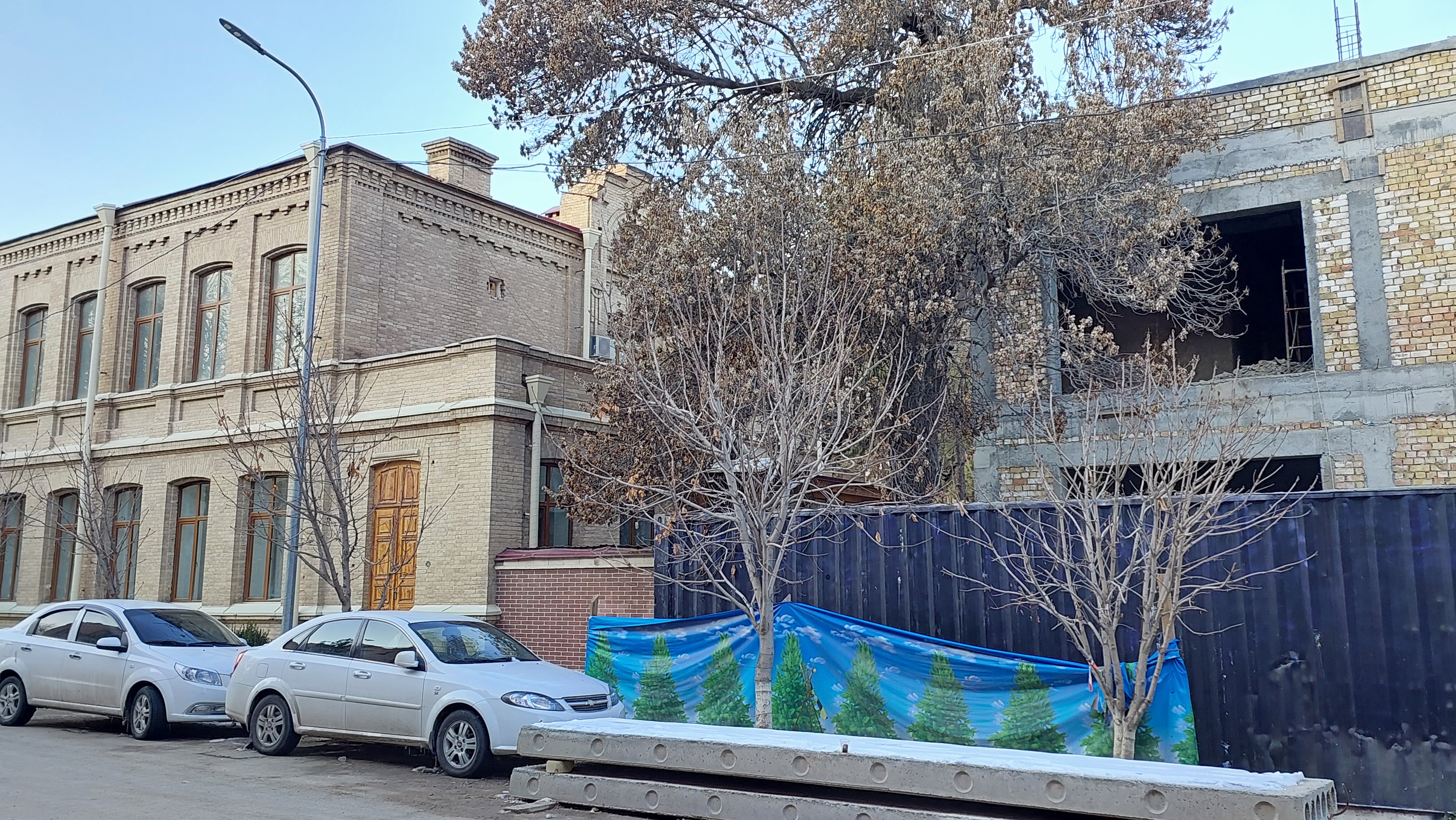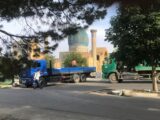SAVE SAMARKAND! Open letter of the civil activists
28.04.2023The President of the Republic of Uzbekistan
The Oliy Majlis of the Republic of Uzbekistan
The Agency of Cultural Heritage of Uzbekistan
The Art and Culture Development Fund under the
Cabinet of Ministers of Uzbekistan
The Ministry of Natural Resources of Uzbekistan
The General Prosecutor’s Office of Uzbekistan
The State Security Service of Uzbekistan
The United Nations Educational, Scientific and Cultural
Organisation (UNESCO)
The United Nations World Tourism Organisation
Silk Road Task Force
The United Nations Development Programme in Uzbekistan
The Delegation of the European Union in Uzbekistan
Alerte Héritage
The World Bank
The European Bank for Reconstruction&Development
The Asian Development Bank (ADB)
Agence Français de Développement (AFD)
Japan International Cooperation Agency (JICA)
CEE Bankwatch Network
URGENT! IMPORANT!
Dear All,
It is with deep concern that I am writing to the government of Uzbekistan and the international community in order to seek an urgent joint action to cease the ongoing destruction of our historic Samarkand.
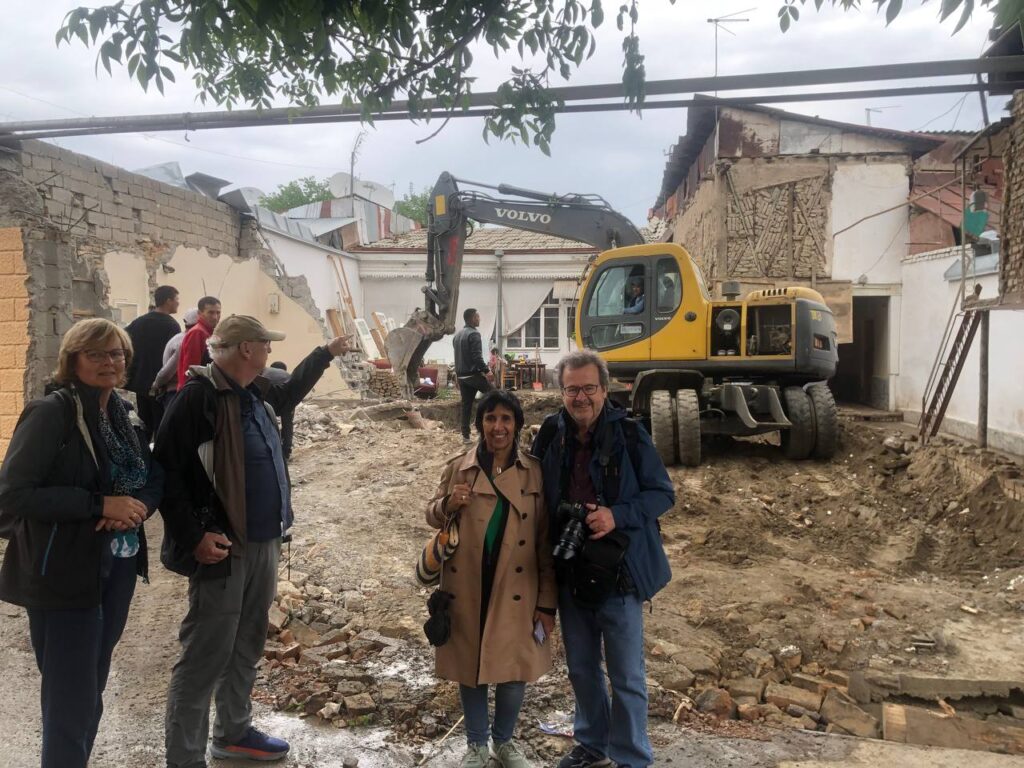
Touristes in Samarkand
The old town of Samarkand is under national and international protection. There, one can walk through every period of regional history: start at the ruins of the ancient Afrasiab, proceed to the Timurid part and walk into the 19thc. architecture and the Soviet constructions. For its “outstanding universal value”, UNESCO has included “Samarkand – the Crossroads of Cultures” in the World Heritage List. National legislation likewise recognizes the old town as a “museum-reserve” under protection. There is also evidence of a political will to protect heritage: new legislation, official statements and appointments.
Notwithstanding the abovementioned, in reality, one walks through chaotic and (nominally) uncontrolled construction, which involves the destruction of national heritage, land grabbing, negligence, laissez-faire building works and window-dressing. The lack of (genuine) implementation of laws, technical administrative shortfalls, failures to investigate and prosecute redevelopment related offences and alleged corruption are the “worms” that have been rapidly eating up the city. For example, there are cases when the national heritage “suddenly” falls and shortly after the expensive stores arise on the spot; or when heritage is deroofed letting the precipitations in for the property not to have “heritage value” any more.
Article 4 of the World Heritage Convention obliges governments to guarantee the safety and transmission to future generations of the items on its list. Unfortunately, the Government of Uzbekistan fails to fulfill its duties. There are dozens and dozens of cases, large and small, that together make up a catastrophe for
the historic town.
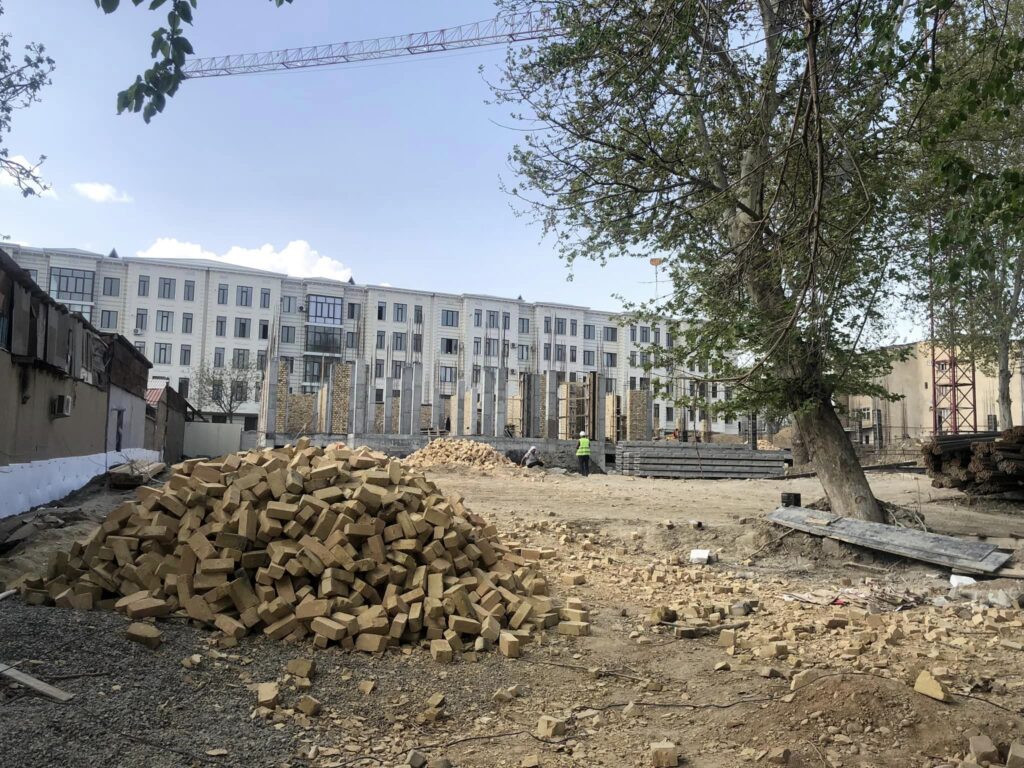
Construction on the former / curent territory of Samarkand State University. Included in the national list of cultural heritage sites. Museum-reserve. UNESCO area
1 Attached are some of the important cases in the museum-reserve: developments around
The University Boulevard, Samarkand City and other constructions on main streets, as well as developments in traditional neighborhoods – guzars [1]. These involve the brutal destruction/harm of the objects 1) from the National Heritage List 2) in the UNESCO protected zone.
Concerns about national historical and cultural heritage. Evidently, the “tourism” or “education” development” umbrellas attract investment in hotels, fake cities, bulky and dominating medical university and other amenities in lieu of the authentic spaces. The Tilla Kori Madrasah’s (17thc. mosque in Registan Squire) crumbles due to the rising groundwater. The atmosphere in the Ishrat-khona Mausoleum (15thc.) is destroyed due to modification works. The new gigantic mosque at the Abdi Darun Mausoleum (12thc.) suppresses the ancient mausoleum, mosque and the surrounding graves. The last remaining ancient inscriptions on the walls of the Bibi Khanum Mosque (15thc.) are being painted in white. There are many
pieces of the 19th -century architecture begging for some professional care.
Archeological concerns. Apparently, the construction of massive buildings are carried out without archeological inspections. For instance, in the excavated pit under the newly erected high buildings the underground parking runs onto alleged remnants of the Timurid Citadel. Parts of archeological sites are given away to restaurants.
Ecological concerns. Moving and reducing minor social infrastructures to remote areas, cluttering and dropping oversized universities on the old town contradicts sustainable development goals. Amongst others, such decisions increase transportation and emissions. Back in 2009, we had many (all) large oriental
platan trees in the Central Park of the museum-reserve substituted by alien fir trees. Clearly, these decisions go against EBRD’s upcoming Green City project and the national green initiatives.

In 2019, following “public outrage” and UNESCO’s appeal, the Presidential apparatus ordered to investigate into all constructions works on the number of streets and for appropriate legal measures to be taken. ICOMOS/WHC Monitoring mission took place in January 2020. Nevertheless, today massive
constructions on those streets are getting higher and larger with ever greater zeal.
Frankly, there is little of “Samarkand – the Crossroads of Cultures” to save any more. And the speed of machinery operating in the museum-reserve is terrifying. Therefore, ahead of the 25th session of the UNWTO Congress to be held in Samarkand in October, 2023, the UNESCO needs to put Samarkand into
the List of World Heritage in Danger under Article 11(4) of the Convention. Uzbekistan as well as the international community has to prove that it is capable to protect the heritage of universal value rather than exploiting Samarkand’s name at the most hypocritical way.
The government shall demonstrate its genuine interest by resolute intervention and continued hard work. Attached are some proposals. Financial units have to reconsider/put additional layer of scrutiny in their cooperation with entities and local banks financing constructions projects in the UNESCO zone. The
cooperation to save Samarkand between the addresses in this letter are vital and greatly appreciated.
MASSIVE CONSTRUCTIONS AT THE “SAMARKAND – CROSSROADS OF CULTURES”
1. University Boulevard. The construction works are currently underway behind the facades of the only remaining large green space in town. On top of being in the UNESCO zone, the original buildings of the Samarkand State University are in the National Heritage List. Supplementary new university blocks are being squeezed into the old campus. As a result, authentic, quiet and cozy courtyards as well as shady trees are wasted. It is also estimated that about 30-35 households will be
demolished and the residents evicted to create campuses for 1000 – 1500 people. The intimacy and the spirit of the old university campus are progressively lost.
Already the largest university in town, with Senator Rustam Kholmurodov as its Rector, has an alleged “public need” for enlargement. Interestingly, however, one of the university buildings had been demolished and a multistory apartment building for sale had been built instead. Furthermore, the territory of another old plant nearby (which could be potentially used for campuses) has been handed over to elite private hotels. Such manipulations with land elsewhere would deserve the
attention of the specialized law enforcement agencies.
Supposedly, a city hospital will be moved to the suburbs transferring its territory to this university as well. Such decisions violate decades-old peoples’ habits of doing life. Recently, a maternity hospital in the old town was transferred to outskirts too.
The Faculty of Biology, the 19th -century masterpiece and the first gymnasium, is being enlarged/pressured by additional buildings by getting rid of smaller authentic ones.
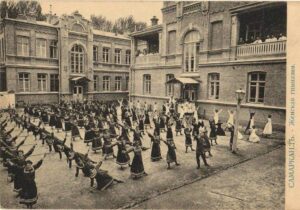
Факультет биологии СамГУ, арх. Сваричевский, 1904 г
Moreover, the faculty had a greenhouse initiated in 1969, which comprises of over 1000 specimens of 250 unique plant species. In 2011-2013, following the cold winter, the greenhouse was completely renovated and enhanced with modern technology with the support of the UNDP GEF Small Grants Programme, Embassies of Germany, Switzerland and the U.S.A. At this moment the greenhouse is going through careless reconstruction again! The condition of the “greenery” will make one’s heart bleed (it is lost!).
![]()
A kind reminder to donors: there is a responsibility before your stakeholders and taxpayers for the sustainability of the financed projects, especially in such country contexts.
2. Guzars (mahallas) of the old town. These are centuries-old neighborhoods around medieval monuments; the houses are often passed down from generation to generation. Each house had an intimate traditional planning suitable for our climate and history. Nowadays, however, there are too, too many instances where people ignore all architectural norms of the area just for the sake of implanting cube-shaped money-making boxes. They put up irrelevant Juliette balconies and windows facing each other and/or the ones of the neighbor; raise two, three or even four-level buildings to arrange as many hotel rooms as possible, and they give up their courtyards for irrelevant roof terraces that destroy the silhouette of the town and serve as frying pans in the Uzbekistani summer.
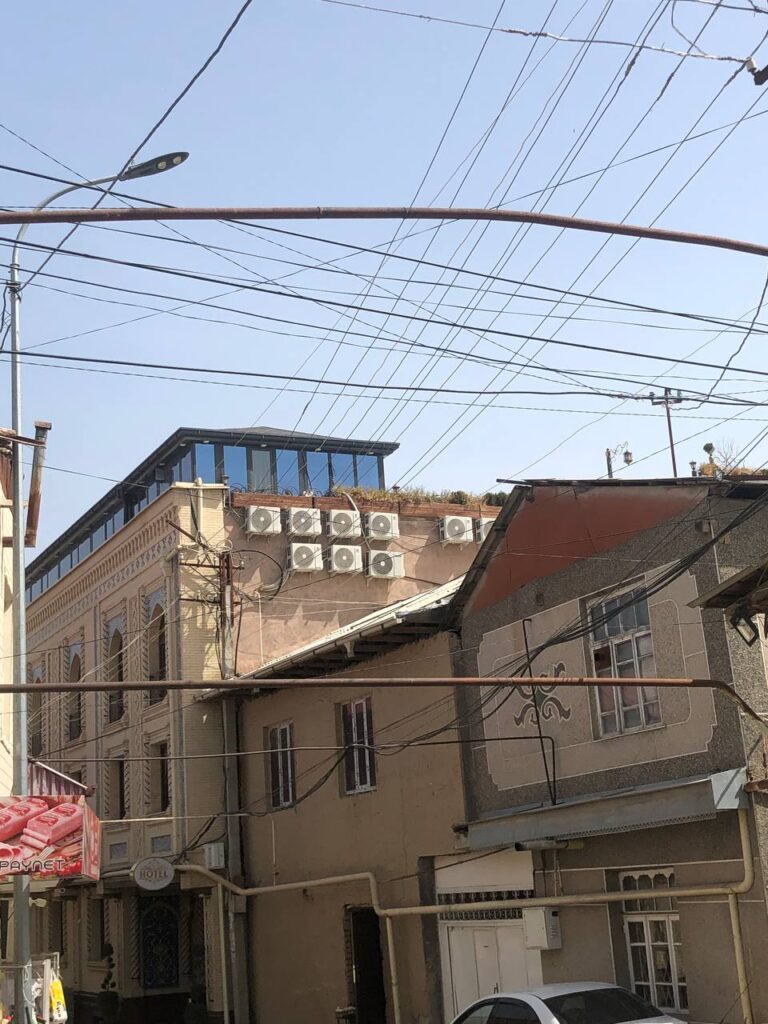
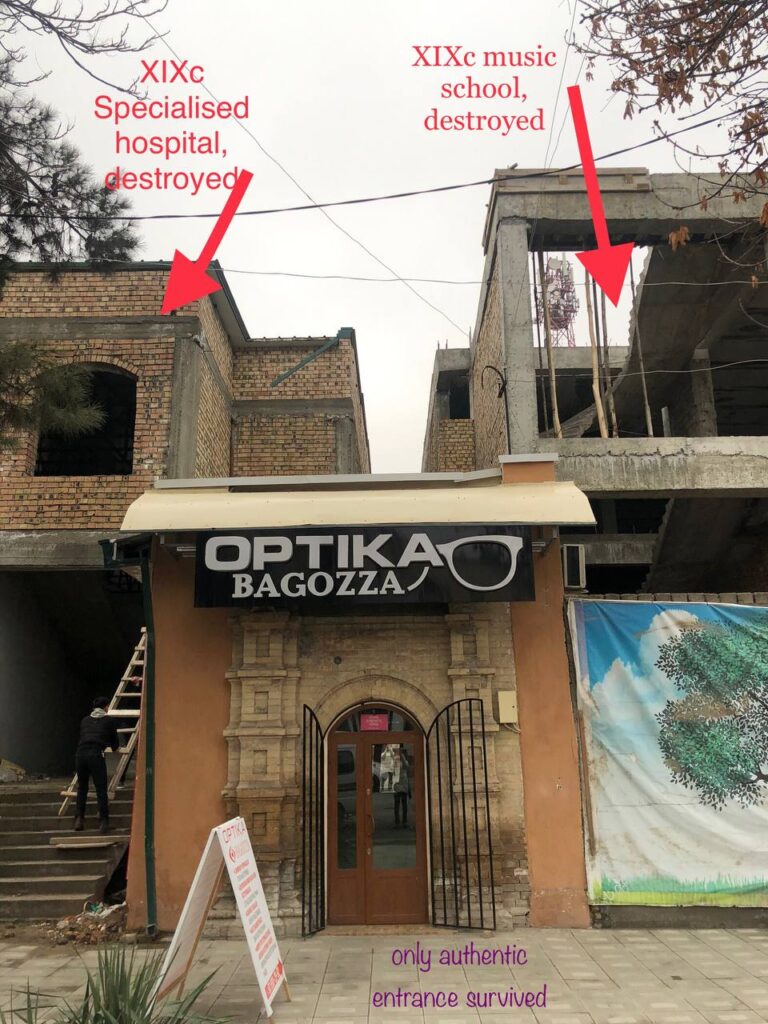
The separating “Berlin” walls between monuments and people’s neighborhoods erected by the previous government “for security reasons” further ruin the authenticity of the historical town. Parts of the ancient city canals (National Heritage List) despite expert and public indignation were piped and covered by concrete; the greenery on their shores was eradicated.
3. Major residential projects main historic streets
a) Samarkand City. The massive construction works of private residential and business blocks are taking place following the demolition of the former Alpomysh factory (National Heritage List) and a number of private houses.
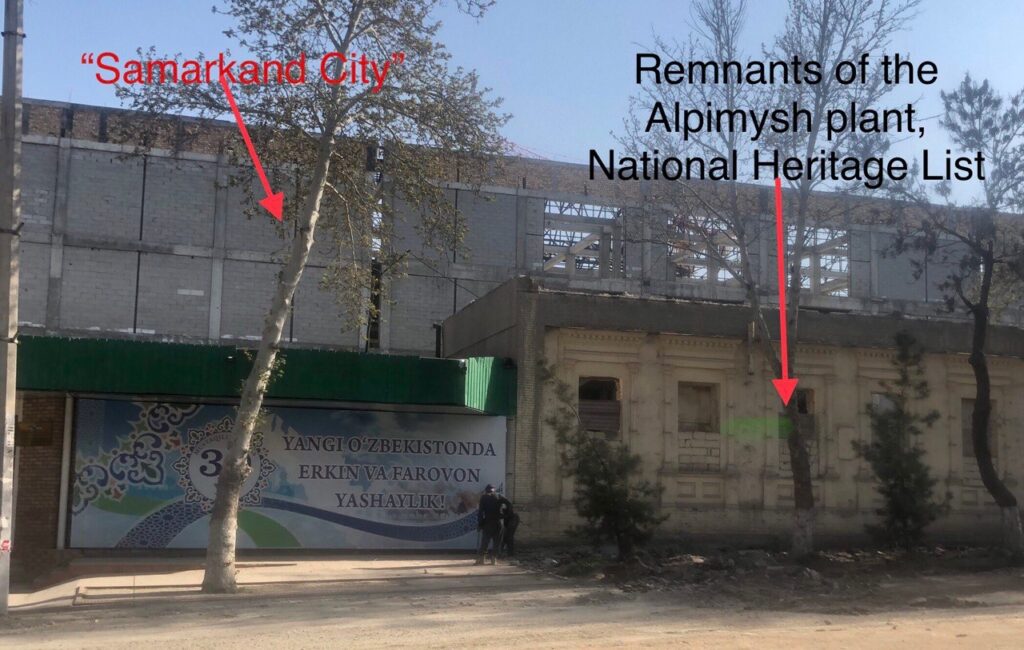
The National Bank of Uzbekistan was appointed as the “main financial unit” for the project (point 6, Decree of the Cabinet of Ministers #450 dated 30.06.2017). The special decree moreover legalizes gracious exceptional benefits: tax exemptions for the investor, operation without tenders and connection of the private apartments to the city’s utility infrastructure at the expense of the local
budget.
b) The 19th -century complex. This large property on Otaturk – Shokhrukh Mirzo intersection from the National Heritage List was used for social purposes: a police unit, a municipal agency, a musical school and a kindergarten prior to being piecemealed. The nine-floored several apartment buildings and a hotel are being raised. No archeological excavations undertaken: allegedly the Timurid Citadel
is found.
Other than a barbaric act towards the national heritage, the massive buildings dominate over/threaten one and four-story buildings of school No. 45 which is located just next to them.
In these projects:
1) the city has lost national heritage sites;
2) in their place in the protected zone, large-scale works are underway;
3) public zones are traded for private interests;
4) the budget is not getting prescribed inputs;
5) the funds from the public budget are channeled to set up the infrastructure
for the business;
6) paradoxically, the heritage properties were destroyed to build amenities for
tourists.
REQUIRED URGENT ACTIONS TO SAVE REMNANTS OF SAMARKAND
1. Put Samarkand into the List of World Heritage in Danger under Article 11(4) of the Convention.
2. Immediately seize all construction, digging and other manipulations with land and property works in the territory of the museum-reserve.
3. Establishment of a Special Committee on the Protection of the National Heritage. The Committee should have powers to detect, monitor, investigate, take a prompt action, etc. in regard to the status quo and implementation of laws. The Committee should be comprised of:
- State representatives (law enforcement, the Senate, Presidential Apparatus, the Agency on the National Heritage)
- Selected experts from Samarkand and elsewhere (architects, urban planners, lawyers, historians, archeologists, etc.).
- Observers from international institutions (UNDP, EU, EBRD and other international financial institutions)
- City activists. I would like to dedicate my knowledge, experience and skills to this initiative.
4. Where there has been illegal construction, demolition/modification of newly erected massive buildings (their parts) that contradict the appearance of the museum-reserve and the heritage protection laws.
5. Develop concrete preservation plan and strategy at least for Samarkand’s old town. It is necessary to think ahead, think “green” & think sustainable!
6. Prepare more precise guidelines for local architects. Educate them and educate the public on rational development and protection of heritage.
7. For foreign entities and international financial institutions:
- Rigorously assess (beyond the regular procedures) the financing of projects in Samarkand
- Reconsider cooperation with Uzbek banks financing dubious projects in Samarkand
- Consider supporting the restoration and conservation of concrete sites in the Samarkand museum-reserve. Expertise is especially needed.
8. Strict adherence to the Recommendations of WHO/ICOMOS Reactive Monitoring Mission 12-16 January 2020 (603 rev., Uzbekistan, 44 COM) and Uzbekistan’s legislation.
NB!!! The abovementioned actions should be meaningful, genuine, adhered to rule of law with zero tolerance to corruption, nepotism, favours, phone calls from above etc.
Please, let’s save Samarkand together!
Sincerely,
Diyora Rafieva, public law and security lawyer (@samarkandcrossroadsofcultures)
Dmitriy Kostyushkin, regional expert
